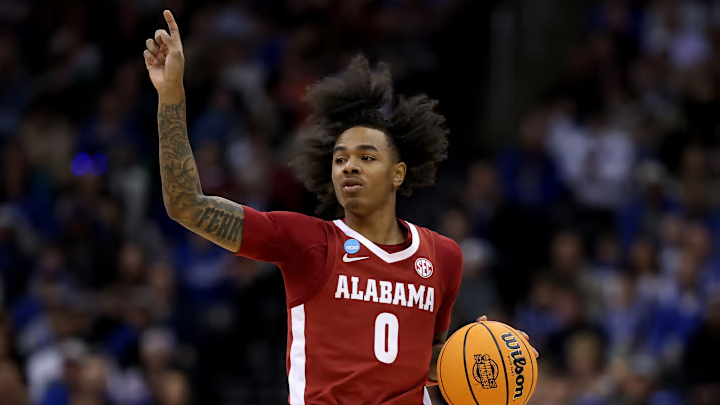Recent history tells us that Nate Oats will put a good basketball team on the floor next season for Alabama. How good that team ultimately can be might come down to the pending decision by freshman guard Labaron Philon.
Philon is weighing whether to enter the 2025 NBA Draft or to return to Tuscaloosa for his sophomore season. Coming off of an SEC All-Freshman performance this season where he was a starting guard on an Elite Eight team, Philon figures to be one of the top guards in the country next season.
But he is firmly on the radar for NBA teams, too. He has the size, athleticism, and basketball IQ that makes him desirable. He may not be ready to contribute to an NBA team immediately, but the NBA often drafts off of projection more than production.
Philon projects as an NBA player, potentially even as a starting guard. At just 19 years old, NBA scouts know they can mold him and help him reach his full potential.
As a freshman, Philon started 29 games and averaged 10.6 points, 3.8 assists, and 1.4 steals in just under 25 minutes per game. His three-point shooting will have to improve for him to be an NBA-caliber guard, but 31.5% is nothing to sneeze at for a freshman.
Philon could do what Mark Sears did last year and enter the NBA Draft while maintaining his collegiate eligibility. That would allow him to work out for teams, potentially participate in the NBA Combine, and gain valuable feedback on what he needs to work on. That decision has to be made before April 27th. He would then have until June 15th to withdraw from the draft and return to school.
They'll likely tell him they want to see him improve as a three-point shooter. They'll also tell him his at the rim finishing needs to improve. At 6-foot-4 and with his athleticism, 58.1% at the rim isn't good enough. Philon flashed plenty of defensive potential, but he had a few too many lapses and wasn't always engaged on that end of the floor. He'll get feedback on that, too.
But the feedback will also be positive, and Philon could work his way into the 1st round range, or even in the lottery, and if so, he would be wise to stay in the draft.
If you look at Bart Torvik's player comparison tool, you'll see why the NBA is intrigued by Philon. The five players who had freshman seasons most similar to Philon's 2024-25 season are all NBA players, and four were 1st round picks.
Bart Torvik's comps are Cason Wallace (2023), Tyty Washington (2022), Gary Harris (2013), Bruce Brown (2017), and Donovan Mitchell (2016). Brown was the only 2nd rounder on the list and he signed a $45 million contract with the Indiana Pacers after playing a big role for the Denver Nuggets when they won the NBA Championship.
Perhaps the most interesting thing about that list of players is that three of them - Mitchell, Brown, and Harris - returned to college for their sophomore seasons before turning pro. Wallace and Washington both jumped to the NBA after their freshman seasons at Kentucky.
Labaron Philon's NBA Draft stock is all over the map
It's hard to get a read on where Philon might get picked were he to declare and stay in the draft. Before the NCAA Tournament started, ESPN NBA Draft expert Jonathan Givony released his Top 100 and had Philon at No. 43.
On the other end of that spectrum, however, is The Ringer's NBA Draft Guide. They have Philon at No. 11.
If Philon can get a lottery or even 1st round guarantee, returning to college for another season would be foolish. But if he's a projected 2nd round pick, there's a significant difference, and he should probably return to school.
1st round NBA draft picks are on guaranteed rookie-scale contracts. That means the first two years of the contract are guaranteed, and then years three and four are team options. 2nd round picks get no guarantees. Those contracts are non-guaranteed, and more times than not, they are two-way contracts, which means the player will spend the majority of their time in the NBA's developmental G-League. That wouldn't be a bad spot for Philon to grow his game, but he can play in the G-League anytime that he wants to, and he'd stand to make more money playing college basketball next season than he would as a 2nd round pick in the NBA.
The last player selected in the lottery last season - Pitt's Bub Carrington - signed a contract with the Washington Wizards for 4 years and over $21 million. The first pick of the second round - San Francisco's Jonathan Mogbo - signed a 3-year deal worth a little over $6 million with the Toronto Raptors.
What's best for Philon isn't necessarily what's best for Alabama. Philon should declare for the draft to at least go through the process and get feedback, even if he feels confident that he's ultimately going to return to school. For the player, there's no harm in it.
For Alabama, it'll cause a delicate balancing act for Oats and the coaching staff. It'll mean Alabama's roster is unfinished as they await Philon's ultimate decision. Oats will have a contingency plan ready, though his hope is that Philon will be back and running his offense in Tuscaloosa next season.
If Philon declares, Alabama will be stuck in no-man's land as they wait-and-see what he'll do. Of course, Oats will be privy to the type of feedback Philon is getting and will, in theory, have a good indication of what he will ultimately do prior to the June 15 deadline to withdraw.
But it's not an easy situation to navigate as Oats builds the roster for next season. It seems like the most likely scenario for what Philon ultimately decides to do, however.
